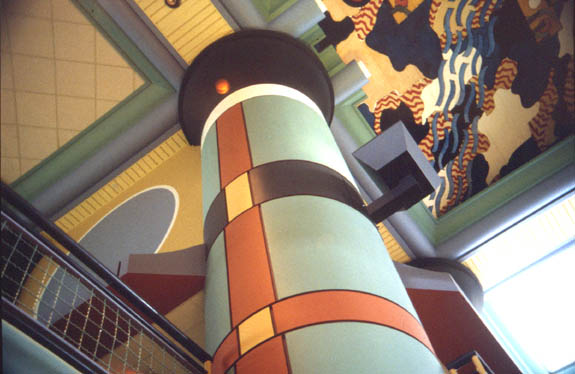

ROUND COLUMNS SUPPORTING THE ROOFThe appearance of the 'Working Order' as an embodiment of the Hypostylar 'Space of Eternity is surface-scripted by the colour green. This is the general colour of all of the rectangular columns in the Duncan interior. The cylindrical ones are more 'original' or 'primordial, than the cubic ones. For, as Serlio laconically remarks, they exist 'inside' the cubic 'pilasters' - from which Serlio advises they are 'born'. We therefore make the cylindrical columns embody more of what they are. The yellow squares are windows which reveal, like the small glass panes on the doors of furnaces, the fire that rages within. This is the shooting fire of the 'trabes' which Pliny poeticises as akin to the tail of a comet. It is the 'colmna lucis' of Indra as he conjoins the two wandering 'oculi' into the Vedic cosmogony. The vertical red stripe is, in Duncan Hall, merely a metaphorical porterage of the idea of this 'vertical event'. The 'red strike' is the 'raising of the Hypostyle from its eternal slumber into the ghastly afterglow of the 'first event' - the 'light'. In the Judge Institute, as befits the literal-minded English, these vertical stripes 'really are' the 12"x12" (30x30cm) concrete anti-gravity pillars. This justifies their existence to these aniconic islanders. The disproportion between the two iconic functions (meanings) of the vertical red elements is an index of the profound conceptual misery of late 20C British Modernism. The owners of the Judge preferred to conjure with the idea that steel and concrete have become so strong as to support an 80'0"-high column on two 12"x12" sticks (infilled with 'stone') than to use the surface of their great 'Order' to embody anything more 'interesting' - thus reducing their building to a stage on which only puerilities play their petty parts. In Texas, the Talking Order discourses a 'literary' architecture that ensures that the JOA architectural invention functions to topologicaly invert the 20C architectural project - focussing the 'gaze' inwards into |Culture and away from the merely literal contemplation of a Romanticised Nature. Duncan Hall is the only one of our many projects in which this 'radical inversion' has been allowed to occur. One must 'reconstruct' all of our other projects (and especially the Judge), in the light of Rice, to imagine them as we would have them to really be. But where else could this first happen but the USA, and where but in the extraordinary Rice Campus? One must never compose anything in a state of simple one-on-one symbolic coding. All creative composiiton is so complex, needing to synthesise so many diverse factors into a single 'simple' solution, that one can never prioritise one factor over another. Designers who argue that they proceed by 'simplifying the question' always lie (if they are any good). Their talent is to complexify the question, but simplify the answer. The horizontal black bands, that stripe the column at each floor level, embody the horizontal axis of the Order. But this is a merely syntactic event of no possible interest to anyone except Architectural Grammarians. It is for its semantic that Architecture is brought into being - a fact that Architects choose to dissimulate while paying it immense attention.The 'raft' that has 'landed' on the hypostylar forest of columns is coloured a fresh blue and green. But the floors that these columns also support are all, as Corbusier called them, 'New Earths'. So they are, in their interior 'substance', black, like the earth of the Nocturnal Nile from which they are 'born every morning'. There is even a black floor-band, as we can see, appearing near the top of the column. This embodies the 'floor' that has been 'deducted in order to bring its idea into being' - after the technique of the 'Kantian Solid'. The Working Order is shown supporting, above all the floors, as well as the 'floor that is not there' - but is in the surrounding 'Service Attic' - the blue logs of the 'raft' whose cargo, the 'Founding Event' is delineated in the 'vault'. Duncan Hall, Rice University, Houston |